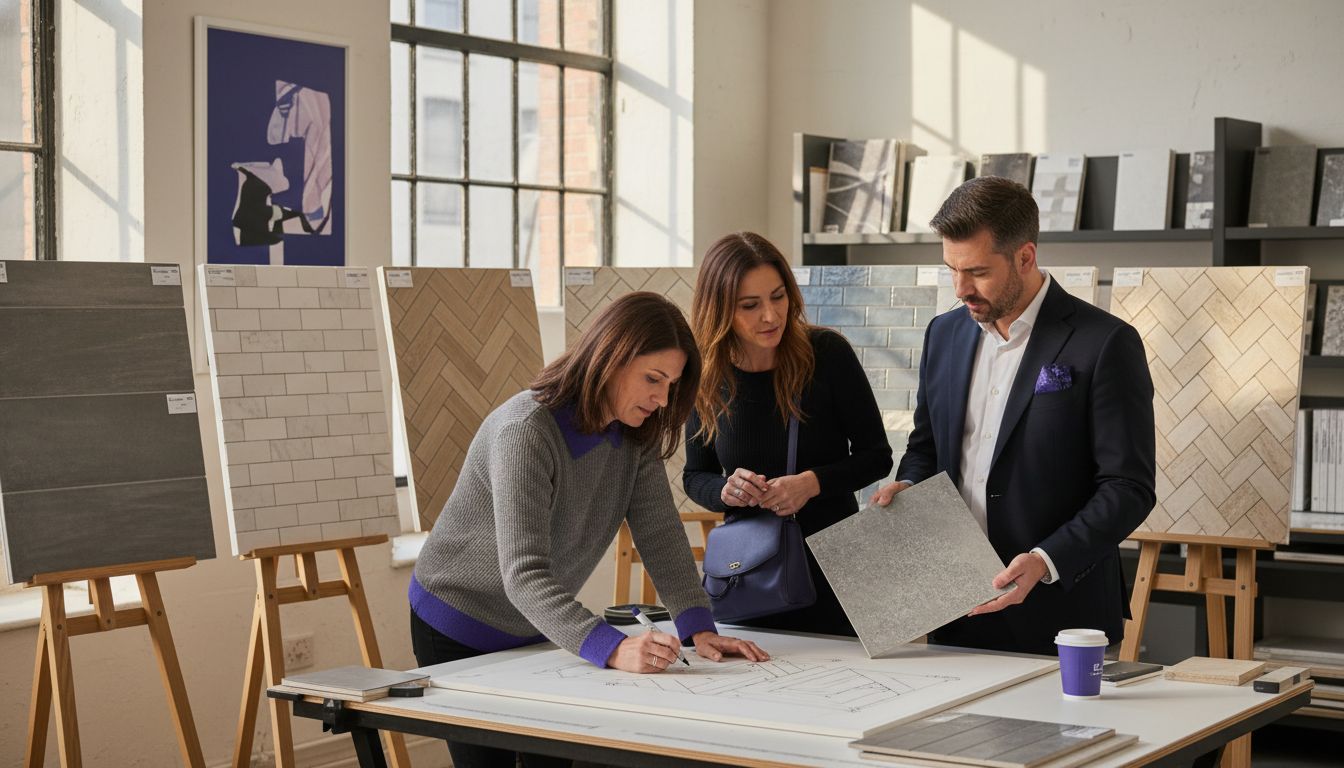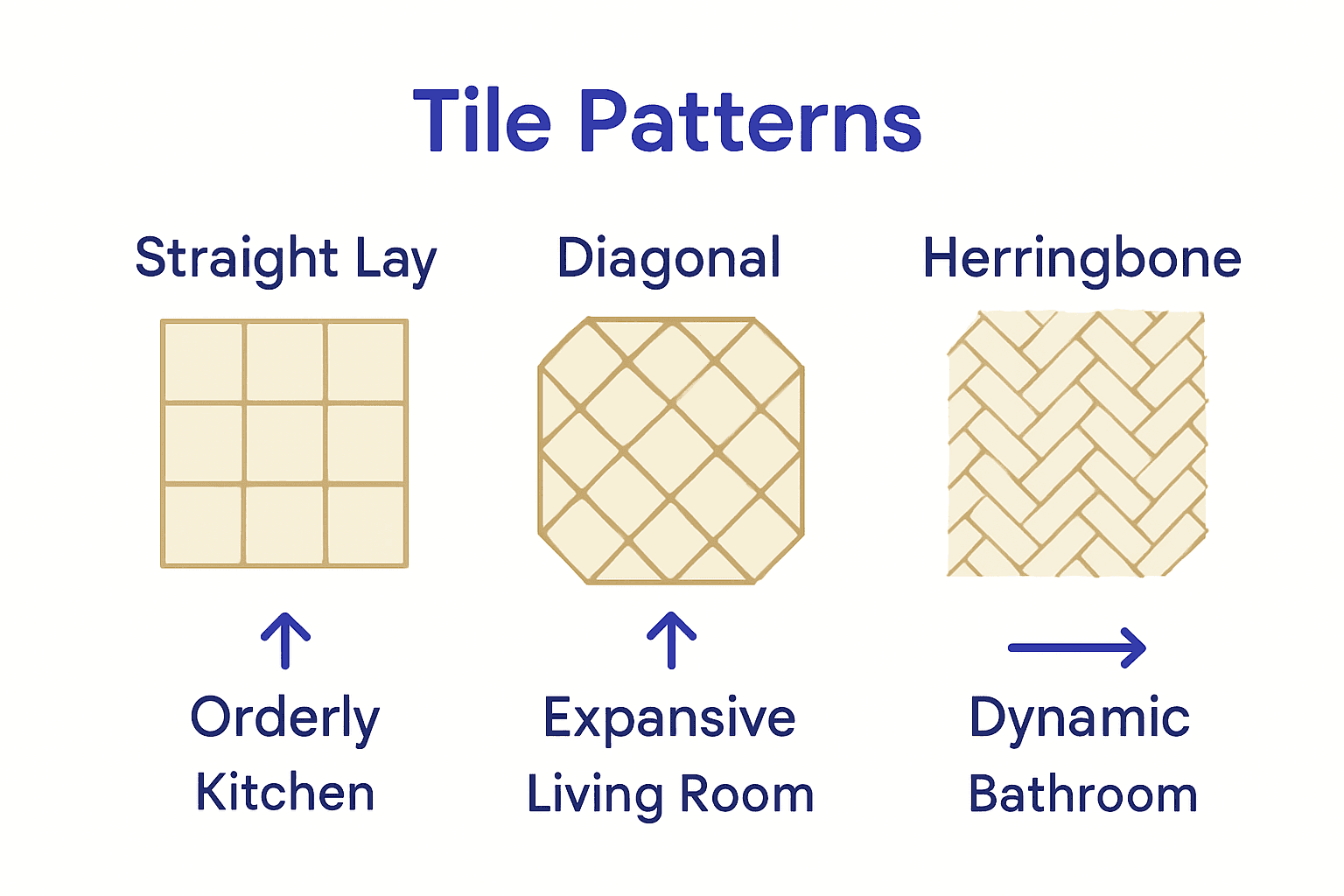Complete Guide to Why Pattern Matters in Tiles
Posted by Mike Belk on Nov 07, 2025

More than 60 percent of people say that the way tile is arranged affects how a room feels and functions. Patterns on floors and walls are not just about looks—they guide our sense of space, connect us to different cultures, and even shape how comfortable we feel. Choosing the right tile pattern can turn any room into a unique story, and this guide sheds light on the secrets behind tile layouts and how they transform ordinary surfaces into works of art.
Table of Contents
- Defining Tile Patterns And Their Significance
- Types Of Tile Patterns And Layout Options
- How Patterns Influence Space And Style
- Selecting Patterns For Functional Needs
- Common Tile Pattern Mistakes To Avoid
Key Takeaways
| Point | Details |
|---|---|
| Tile Patterns Communicate Design | Tile patterns serve as visual languages that embody cultural heritage and mathematical precision, enhancing both aesthetic and spatial perceptions. |
| Influence of Layout on Space | Strategic selection of tile layouts can significantly alter the perception of space, making areas appear larger or more dynamic based on the pattern chosen. |
| Functional Considerations in Selection | Choosing the right tile pattern addresses specific functional needs, enhancing room perception, maintenance, and traffic flow. |
| Avoiding Common Mistakes | Simple design principles should be followed to avoid clutter and ensure harmonious integration of tile patterns within a space. |
Defining Tile Patterns and Their Significance
Tile patterns represent more than just decorative arrangements; they are intricate visual languages that communicate design complexity, spatial perception, and cultural heritage. According to Radius Foundation, traditional tile patterns go beyond aesthetic appeal, embodying complex geometrical structures that reveal profound mathematical and cosmological understanding.
At its core, a tile pattern is a systematic arrangement of tiles that creates visual rhythm, balance, and movement across a surface. These patterns can range from simple grid-like layouts to extraordinarily complex geometric designs that challenge visual perception. PubMed research from 2025 reveals that humans are remarkably sensitive to irregularities in periodic tiling patterns, suggesting that our brains inherently respond to symmetry and regularity.
Key characteristics of tile patterns include:
- Visual continuity and flow
- Spatial transformation
- Mathematical precision
- Cultural storytelling
- Aesthetic complexity
The significance of tile patterns extends far beyond mere decoration. They serve as architectural storytellers, transforming ordinary surfaces into narratives of design, culture, and human creativity. Whether mimicking natural forms, representing mathematical principles, or conveying cultural symbolism, each pattern tells a unique story through its strategic arrangement and visual language.
For those eager to explore more about the fascinating world of tile design, check out our understanding the role of tile patterns guide, which dives deeper into the intricate relationships between pattern, space, and aesthetic expression.
Types of Tile Patterns and Layout Options
Tile patterns are not just about covering surfaces; they are strategic design elements that transform spaces through their unique arrangements. JJVS provides a comprehensive overview of tile patterns, revealing that each layout offers distinct aesthetic and functional benefits tailored to specific environments.
The most common tile layout patterns range from classic to contemporary designs. According to Cornerstone Builders, popular layouts include:
- Straight Lay: Traditional grid pattern, tiles aligned parallel to walls
- Diagonal: 45-degree angle installation creating visual movement
- Subway/Brick: Offset rectangular tiles mimicking classic brickwork
- Herringbone: Zigzag pattern creating dynamic visual interest
- Basketweave: Interlocking square tiles for textural complexity
Each pattern communicates a unique design language.
 Straight lay patterns offer clean, minimalist aesthetics perfect for modern spaces, while diagonal layouts can make rooms appear larger and more dynamic. Herringbone and basketweave patterns introduce sophisticated visual texture, transforming ordinary surfaces into artistic statements.
Straight lay patterns offer clean, minimalist aesthetics perfect for modern spaces, while diagonal layouts can make rooms appear larger and more dynamic. Herringbone and basketweave patterns introduce sophisticated visual texture, transforming ordinary surfaces into artistic statements.
Here’s a comparison of popular tile layout patterns and their unique characteristics:
| Pattern Name | Visual Effect | Best Used For | Distinctive Feature |
|---|---|---|---|
| Straight Lay | Clean, orderly appearance | Modern, minimalist spaces | Aligns with walls, simple grid |
| Diagonal | Expansive, dynamic movement | Small or narrow rooms | Installed at 45-degree angle |
| Subway/Brick | Subtle texture, classic style | Kitchens, bathrooms | Rectangular tiles, offset rows |
| Herringbone | Sophisticated, visual energy | Entryways, living areas | Zigzag pattern with rectangles |
| Basketweave | Rich texture, intricate look | Traditional interiors | Interwoven squares and rectangles |
Understanding these patterns helps homeowners and designers select layouts that complement room dimensions, architectural styles, and personal aesthetic preferences.
 For those looking to explore more design possibilities, our tile patterns and designs guide provides deeper insights into creating visually stunning spaces through strategic tile arrangements.
For those looking to explore more design possibilities, our tile patterns and designs guide provides deeper insights into creating visually stunning spaces through strategic tile arrangements.
How Patterns Influence Space and Style
Tile patterns are powerful visual tools that dramatically transform the perception and feel of interior spaces. This Enchanted Pixie reveals that strategic pattern selection can fundamentally alter spatial perception, with techniques like diagonal tile layouts making rooms appear significantly larger and more open.
The psychological impact of tile patterns extends far beyond simple decoration. RISPA highlights how specific arrangements like herringbone patterns add timeless elegance while simultaneously influencing a room’s perceived dimensions. Different patterns create unique visual experiences:
- Diagonal Layouts: Expand spatial perception
- Herringbone Patterns: Create dynamic visual movement
- Grid Patterns: Establish order and symmetry
- Staggered Layouts: Introduce visual complexity
Moreover, tile patterns communicate design intent and architectural personality. A carefully chosen pattern can make a small bathroom feel more spacious, transform a kitchen’s energy, or add sophistication to a living area. The interplay between tile orientation, size, and arrangement becomes a nuanced language of design, speaking volumes about style and spatial creativity.
For interior design enthusiasts seeking deeper insights, our understanding the role of tile layout patterns guide offers comprehensive strategies for leveraging tile patterns to enhance your living spaces.
Selecting Patterns for Functional Needs
Choosing the right tile pattern is not just about aesthetics, but about solving specific functional challenges in different spaces. JJVS recommends strategic pattern selection, particularly for smaller areas like bathrooms and kitchens, where the right layout can dramatically transform spatial perception.
Room-Specific Pattern Strategies involve understanding how different tile arrangements impact functionality and visual experience. According to Cornerstone Builders, vertical brick layouts are particularly effective for visually expanding compact spaces by drawing the eye upward, creating an illusion of increased height and openness.
Key functional considerations for pattern selection include:
- Space Perception: Diagonal and herringbone patterns can make rooms feel larger
- Traffic Flow: Linear patterns can guide movement through spaces
- Maintenance: Smaller, more intricate patterns can better hide dirt and wear
- Visual Balance: Patterns should complement room dimensions and architectural features
Practical pattern selection goes beyond visual appeal, addressing real-world challenges like moisture resistance, durability, and spatial optimization. By carefully matching tile patterns to specific functional needs, homeowners can create spaces that are both beautiful and intelligent in their design approach. For those seeking more detailed guidance on navigating these design choices, our understanding the role of tile layout patterns guide offers comprehensive insights into making informed tile selection decisions.
Common Tile Pattern Mistakes to Avoid
Tile pattern selection is an art form that requires careful consideration and strategic planning. RISPA warns that one of the most critical errors homeowners make is overcomplicating their design by incorporating too many conflicting tile patterns, which can result in a visually chaotic and disjointed space.
The visual complexity of tile design demands thoughtful approach. This Enchanted Pixie highlights that failing to consider room size and lighting can completely undermine your design intentions, creating spaces that feel overwhelming or underwhelming.
Common tile pattern mistakes to avoid include:
- Mixing too many competing patterns
- Ignoring room proportions and natural light
- Selecting patterns without considering scale
- Neglecting the room’s overall design aesthetic
- Overlooking tile orientation and potential visual effects
Successful tile design requires a nuanced understanding of spatial dynamics and design principles. Thoughtful pattern selection goes beyond mere decoration, transforming spaces into harmonious, visually compelling environments. For those seeking to elevate their tile design skills, our patterned tiles guide offers comprehensive insights into creating stunning, cohesive tile layouts that truly enhance your living spaces.
Elevate Your Space with the Perfect Tile Pattern
Choosing the right tile pattern can transform any room from ordinary to extraordinary while addressing common challenges like limited space or lack of visual flow. This article highlights how patterns like herringbone, diagonal, and subway layouts influence spatial perception and style. If you’re struggling to find a tile design that balances beauty and function, understanding these concepts is key to making confident decisions that enhance both aesthetics and practicality.
Discover how BELK Tile makes it easy to apply these powerful design principles in your home or commercial project. Explore our diverse collection of high-quality tiles across styles and materials on our main site. For inspiration on pattern choices and layout ideas, check out our detailed guides on tile patterns and designs and understanding the role of tile layout patterns.
Don’t wait to bring your tile vision to life. Visit BELK Tile today to browse products that combine style, durability, and design versatility. Start crafting a space that truly reflects your creativity and meets your functional needs now.
Frequently Asked Questions
What are tile patterns and why are they significant?
Tile patterns are systematic arrangements of tiles that create visual rhythm and balance. They are significant as they communicate design complexity, spatial perception, and cultural heritage, going beyond mere decoration to tell a unique story.
How do different tile patterns influence the perception of space?
Different tile patterns can dramatically alter how a space feels. For example, diagonal layouts can make rooms appear larger, while herringbone patterns add dynamic visual movement, ultimately affecting the room’s ambiance and spatial perception.
What are the most common tile layout patterns?
Common tile layout patterns include Straight Lay, Diagonal, Subway/Brick, Herringbone, and Basketweave. Each offers distinctive aesthetic and functional benefits tailored to various environments.
What mistakes should I avoid when selecting tile patterns?
Common mistakes include mixing too many competing patterns, ignoring room proportions and natural light, selecting unsuitable patterns without considering scale, overlooking the room’s overall design aesthetic, and neglecting tile orientation. Successful tile design requires careful planning and consideration of these aspects.



